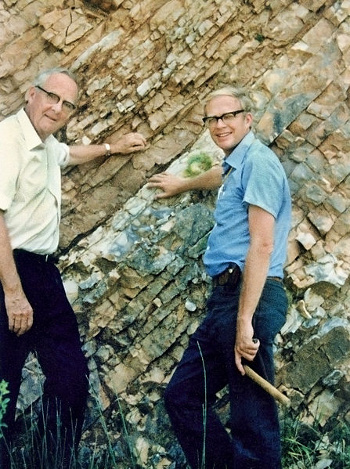Outside the Comfort Zone
July 15, 2013
I still remember a
decades' old
cartoon, probably from
The New Yorker, that repository of contemporary
philosophy in cartoon,
sound-bite format. Since I'm a
materials scientist, it's probably its reference to
aluminum that bonded it to my
brain. Two older men are having
cocktails, and one is telling the other,
"I've learned a lot in my life. Unfortunately, all of it is about aluminum."
In the past, a
scholar could devote his entire life to one particular subject area. There's the saying that a
specialist is someone who knows more and more about less and less. Today, especially in
science and
technology, it's impossible to make a career by burying your head in a single book. You need to transcend your
comfort zone. As a single example, every
scientist, no matter what the
discipline, needs to be adept at
statistics and a master of his
desktop computer.
When members of one traditional discipline apply their knowledge to solving problems in another, you often get a great advance in technology. I've written two articles about novel
DNA sequencing technologies invented by
physicists,
computer scientists and
electrical engineers to advance
genetics (
Full Genome Sequencing, June 7, 2012 and
DNA Analysis, September 17, 2010).
One interesting example of
interdisciplinary work is the
research on the
Cretaceous–Paleogene extinction event, also known as the K-T extinction event, by the father and son team of
Luis Alvarez, a
Nobel Laureate in physics for his work on
subatomic particle detection, and his son
Walter Alvarez, a
geologist. Also involved were the
chemists,
Frank Asaro and Helen Michel.

Luis (left) and Walter Alvarez.
In a previous article (Near Earth Asteroids, October 5, 2011), I wrote about Frank Asaro's recollection of the father-son team asking for an iridium analysis as a favor.
Said Asaro, "There was no funding for these measurements, so we had to squeeze them in with our other work."
(Lawrence Berkeley Laboratory photograph, via Wikipedia.)
This interdisciplinary team found that the
sedimentary layer laid down at the time of this
extinction event was enriched in
iridium, which is rare in
Earth's crust, since it's
soluble in
iron and has become part of
Earth's core. Crustal sources of iridium are
asteroids which have impacted Earth as
meteorites. Their hypothesis is that this extinction of the
dinosaurs and concurrent
species was caused by the impact of a large asteroid. Recent evidence indicates that the impact may have occurred in the
Yucatán Peninsula, near
Chicxulub.
My own specialty of
materials science combines the fields of physics, chemistry and
engineering. Nanotechnology can be considered the
poster child for interdisciplinary research in the
physical sciences. The
American Chemical Society has published its nanotechnology journal,
ACS Nano, since 2007; and the
Institute of Electrical and Electronics Engineers has published
The IEEE Transactions on Nanotechnology since 2002.
Although it can be argued that the science of nanotechnology started with physicist
Richard Feynman's 1959 lecture, "
There's Plenty of Room at the Bottom," neither the
American Physical Society, nor the
American Institute of Physics, have topical journals on nanotechnology. Such articles are divided among their many physics journals.
Commercial publishers jumped into nanotechnology publication very early on, and a search will reveal many titles.

A nano image of a macro character. Everyone uses this photograph from Feynman's Manhattan Project ID badge, since there are licensing issues with all other images.[2]
(Via Wikimedia Commons.)
Another area enjoying input from many scientific specialties is
environmental science. Scientists from many different disciplines are addressing the important issues of
global warming and the increased
atmospheric concentration of carbon dioxide. Atmospheric carbon dioxide has just reached 400
parts per million, which is probably the highest level in the
past three million years.[1]
Space scientists employ
remote monitoring of Earth's environment by
satellites; physicists and electrical engineers are developing techniques to
harvest energy from
renewable resources; and chemists are researching methods for
carbon sequestration. Electrical engineers, such as
Charles Steinmetz and
Nikola Tesla entered this game very early with their work on
hydroelectric power.
I'll conclude by mentioning the necessity of
lifelong learning for scientists. The
Red Queen Effect is as active as ever in the sciences. Said the
Red Queen in
Lewis Carroll's "Through the Looking-Glass,"
"Now, HERE, you see, it takes all the running YOU can do, to keep in the same place. If you want to get somewhere else, you must run at least twice as fast as that."[3]

Lewis Carroll was the pen name of mathematician, Charles Dodgson (1832 - 1898). Dodgson was also one of the first photographers, and his photos demonstrated amazing technical perfection for his time. His subjects included Michael Faraday and Alice Liddell (shown), the inspiration for Alice's Adventures in Wonderland.
This 1858 photograph of Alice as a beggar-maid was published in Dodgson's 1898 biography, "The Life and Letters of Lewis Carroll," by his nephew, Stuart Dodgson Collingwood.
(Photo by Charles Dodgson, via Wikimedia Commons.)
References:
- Robert Kunzig, "Climate Milestone: Earth's CO2 Level Passes 400 ppm," National Geographic News, May 9, 2013.
- In my 2011 communication with the Archives and Special Collections department of the California Institute of Technology, I found that the Feynman heirs claim rights to the name and likeness of Feynman, based on celebrity rights. I can send the contact information for the licensing agent to interested individuals.
- Lewis Carroll (Charles Dodgson), "Through the Looking-Glass," The Millennium Fulcrum Edition 1.7, via Project Gutenberg.
Permanent Link to this article
Linked Keywords: Decade; cartoon; The New Yorker; philosophy; sound-bite; materials science; materials scientist; aluminium; aluminum; brain; cocktail; scholar; expert; specialist; science; technology; comfort zone; scientist; discipline; statistics; desktop computer; DNA sequencing; physicist; computer scientist; electrical engineer; genetics; interdisciplinarity; interdisciplinary; research; Cretaceous–Paleogene extinction event; Luis Alvarez; Nobel Prize in Physics; Nobel Laureate; subatomic particle; Walter Alvarez; geologist; chemist; Frank Asaro; iridium; Wikipedia; sediment; sedimentary layer; extinction event; Earth's crust; solubility; soluble; iron; Earth's core; asteroid; meteorite; Alvarez hypothesis; dinosaur; species; Yucatán Peninsula; Chicxulub; engineering; nanotechnology; poster child; physical sciences; American Chemical Society; ACS Nano; Institute of Electrical and Electronics Engineers; The IEEE Transactions on Nanotechnology; Richard Feynman; There's Plenty of Room at the Bottom; American Physical Society; American Institute of Physics; Commercial publisher; Manhattan Project; ID badge; license; licensing issues; Wikimedia Commons; environmental science; global warming; atmospheric concentration of carbon dioxide; parts per million; geologic time scale; past three million years; space research; space scientist; remote sensing; remote monitoring; satellite; energy harvesting; renewable energy; carbon sequestration; Charles Steinmetz; Nikola Tesla; hydroelectricity; hydroelectric power; lifelong learning; Red Queen Effect; Red Queen; Lewis Carroll; mathematician; photographer; Michael Faraday; Alice Liddell; Alice's Adventures in Wonderland.